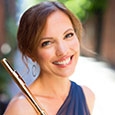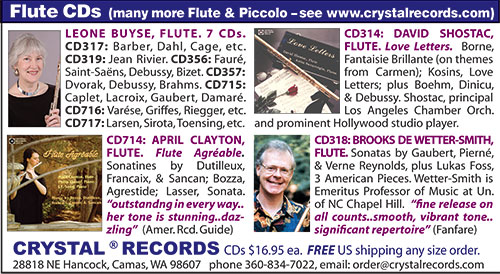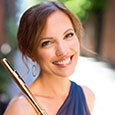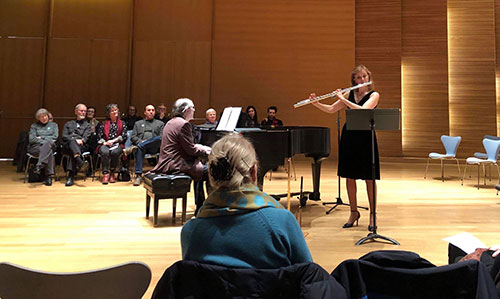
Crafting a recital program is much like planning an exquisite meal. From start to finish, each carefully prepared course must have a cohesive flow to the next. Elements of surprise, such as an unexpected flavor, texture, or visual presentation, allow the diner to embark on an original and unique experience every time. In designing a culinary journey, a great chef must learn to balance the five tastes – sweet, bitter, salty, sour, and the fifth taste, umami, which can simply be described as savory “deliciousness” – with skill, finesse, and an imaginative spirit. In drafting a recital program, the same elements of balance, cohesion, variety, and adventure are paramount to creating a satisfying and memorable experience for the listener.
As both a classical and jazz flutist, I am continually challenged in my efforts to build programs that are both compelling and accessible to a vast audience, while incorporating the music I am passionate about. One of my very favorite programs was a concert I performed at the Grand Rapids Art Museum in Michigan, where I was joined by my duo partner, the venerable Grammy Award-winning jazz pianist, composer, and arranger Bob James. A classically trained pianist as well as an iconic jazz artist and unique and prolific composer, Bob and I share a love for taking an audience on a new and adventurous journey. We also share a strong commitment to honor the traditions of our craft in both genres with authenticity. It is at this intersection of tradition and innovation, coupled with the confluence of the jazz and classical idioms, where we find our most inspired and compelling ideas – our version of umami – for recital programming.
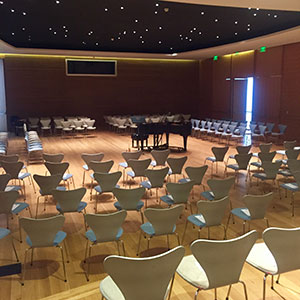 The concert venue, in this case a beautiful performance space in an art museum, plays an important role in selecting fitting and appropriate repertoire. For this program, the drafting table was a riveting place to be. In performance, we would be surrounded by the artistic work of masters both ancient and modern, playing in a lovely acoustical space with a ceiling illuminated to look like the starry midnight sky. So much possibility!
The concert venue, in this case a beautiful performance space in an art museum, plays an important role in selecting fitting and appropriate repertoire. For this program, the drafting table was a riveting place to be. In performance, we would be surrounded by the artistic work of masters both ancient and modern, playing in a lovely acoustical space with a ceiling illuminated to look like the starry midnight sky. So much possibility!
Beginning the program with the music of Bach was a natural and easy choice. I selected the Sonata in E Major BWV 1035, one of my favorite works. I particularly love the improvisatory feel of the opening Adagio ma non tanto, as well as the joyful spirit of the Allegro movements. This sonata makes for a wonderful concert opener, and an inviting welcome to the audience. Playing the music of Bach with a classically influenced jazz pianist, who is also a jazz-influenced classical pianist, is especially rewarding. There are many similarities to be drawn between the music of Bach and the jazz language, and this kinship is something we revisited later in the program.
Next, we programmed the Canzone, Opus 38a by Samuel Barber, followed by Sigfrid Karg-Elert’s Impressions Exotiques, Opus 134. Both Barber and Karg-Elert are 20th century composers with a uniquely rich and complex harmonic language, and we were drawn to include their works in the evolution of our program. Barber’s Canzone, originally titled Elegy by the composer and later expanded and orchestrated to become the second movement of his Piano Concerto, is based on a lush and mournful melody, predominantly in the key of C# minor – the relative minor compliment to Bach’s spirited turn in E Major.
Karg-Elert’s Impressions Exotiques is nearly a full recital program in itself, containing five distinct, diverse, and programmatic movements: Idylle champêtre, Danse pittoresque, Colibri (“Hummingbird,” written for piccolo), Lotus, and Evocation à Brahma. It is like nothing else on the program. This dramatic work is characterized by unique tone colors and technical challenges for both instruments, constant meter changes, and frequent flirtations with atonality. In describing his music, Karg-Elert says: “I strive for, but not by force, an ever more prominent Impressionistic sound, which lets me avoid the idiom of a sprawling theme: it pushes me onward toward a concentrated aphorism. My quick understanding of situations, my quick gain of inward and outward impressions, my preference for many rapid changes, my inner restlessness loves to express itself in tight but sharp pictures.” From impressionistic influences and Far East exoticism to cheeky cabaret references and sudden simplistic cadences, the originality, humor, complexity, and beauty in Karg-Elert’s writing provided just the kind of challenge and adventure we seek for ourselves as performers and for our audience.
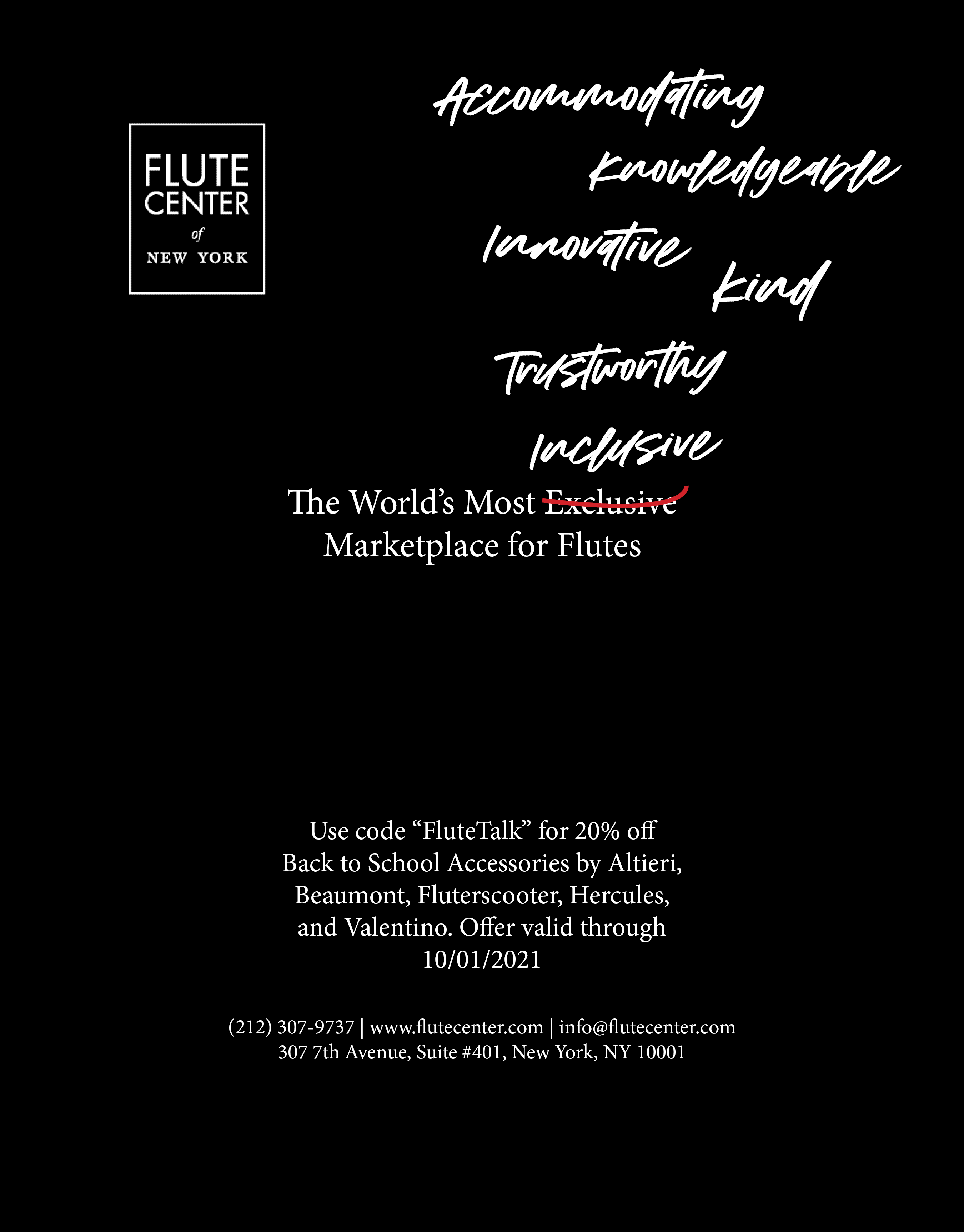
From here, the program veered from its classical course and began to reach into the uniquely distinct collection of original compositions written by Bob James for our duo. Planning and performing concerts with a composer and arranger at the piano is an extraordinary opportunity, and Bob has created several new works and arrangements throughout our time recording and concertizing together. “There is no better motivator for a composer than the presence of two basic ingredients, which I was fortunate to have on this occasion,” James explains. “First, a willing performer at the top of his or her craft, and second, a venue with an appreciative, discerning audience. Nancy Stagnitta’s invitation to join her as a duo partner, and her willingness to venture into whatever diverse styles our imagination could conceive, guaranteed a memorable day of music-making… and it turned out to be just that.”
To transition from the language of Karg-Elert to this next phase of the program, we chose to program Bob’s arrangement of Charlie Chaplin’s simple and wistful tune, Smile. Created for our 2017 album, In the Chapel in the Moonlight, this arrangement begins with a rubato rendering of the tune shared by both players, leading to a swinging and virtuosic variation.
Next, we maintained the high level of energy set forth in Smile as the piccolo made its return for a Bob James original entitled J.S. Bop. Inspired by the contrapuntal writing of the renowned “J.S” already introduced in this program, and representing a nod to our duo as well (James and Stagnitta), this piece is a tour de force, be-bop romp for both players.
Staying in the jazz idiom but feeling a desire to shift the mood at this point in the program, we selected the beautiful jazz ballad Moonlight in Vermont by Karl Suessdorf for the next piece. I chose to perform it on alto flute in order to lend a deep, soulful voice to its beautiful melodic line. This is one of the first jazz tunes I learned and fell in love with many years ago, and I first played it with Bob in an impromptu setting at a jazz club. We had subsequently programmed it for a concert at Interlochen, and during the dress rehearsal, Bob was inspired to create a new arrangement that completely reharmonized the melody, creating a prayerful, solemn, Gospel-like aura. It was so arresting that we knew we wanted to recreate that mood for our audience at the museum.
This tune afforded the first opportunity for improvisation in the program. To interweave the skills and artistic demands required to interpret the written music of others along with the spontaneity and vulnerability needed to create improvised ideas, all within the same recital program, is one of my greatest challenges and greatest joys. Both call for a highly attuned sense of communication and intuition between the performers, which in turn allows the audience to witness and to participate in a very personal connection with the musicians and the music.

Our next selection was a piece co-composed by Bob James and myself. Bob wrote a romantic, cinematic melody titled Bijou, and I wrote a blues tune I called Birdbrain Blues, which we later renamed Scrapple from the Chapel as an homage to Charlie Parker’s Scrapple from the Apple. Bob’s arrangement weaves these two pieces together in a fantastical way, moving from the lyricism of the Bijou theme to the bluesy Scrapple and back again, featuring both composed interplay and ample opportunity for shared improvisation.
The final stop on this recital adventure was Heartstorm, another original work written by Bob for our album. This piece is a rhapsodic odyssey for both players and features two written cadenzas for the flute. It will surely earn its place in the classical flute and piano canon.
As an encore, we performed a medley of the title track from our CD, Bob’s arrangement of In the Chapel in the Moonlight by Billy Hill, and his original tune Angela, which became known as the theme song for the television series, Taxi. We returned to our earlier moonlit subject matter, performing under the simulated starry sky; I returned to the husky jazz voice of the alto flute; and we once again traded improvised ideas in this final offering.
At first glance, a program beginning with the music of Bach and ending with the theme music for a 1970’s sitcom might seem implausibly eclectic, disjunct, or simply too varied to offer the necessary balance and cohesion I mentioned earlier. Eclecticism for eclectism’s sake can be confusing and draining for the listener, just as a meal with clashing flavors and tastes can be less than gratifying. However, with careful thought and planning, ensuring that the repertoire unfolds and evolves organically and in a way that will make sense to the listener, it is entirely possible to successfully program a vast variety of works representing multiple genres.
This particular program remains one of my favorites not only for the diversity and progression of the repertoire we chose, but also for its meaningful history for this unique duo, and for its power to touch and transport an audience. As with any program, we as performers must gain the trust of the listeners, allowing them to feel confident in knowing that the journey they are about to embark upon with us will be a true adventure filled with clear intention, committed and passionate artistry – and no small amount of musical umami.
* * *
How to Build a Recital Program
Here are some tips for crafting a compelling, cohesive recital program. Guidelines will vary depending on whether the performance is a student recital, a professional concert, or in fulfillment of a degree program.
• Imagine yourself as an audience member. Does the program excite you as a listener just as much as it does as the performer?
• Consider program length. Particularly if you are a student, you may have specific timing guidelines to follow, and this could be a minimum or maximum length requirement. A concert venue may also have guidelines.
• Take stamina into account. Be sure that your program allows you to bring your best energy from start to finish. Audience stamina is also important to remember! For longer programs, consider adding a brief intermission.
• A recital program should have a beginning, a middle, and an end. Some performers prefer to start with a short, attention-grabbing nugget, then moving to more substantial and lengthier works. Others begin with their weightiest repertoire, moving later to shorter show pieces. It can also be effective to combine the two, beginning with a shorter, lighter work, progressing to larger repertoire, and finishing with a bonbon or two.
• The question about programming a concerto on a recital is often raised. Traditionally, recitals include unaccompanied works and those scored for flute and piano, as well as chamber music repertoire, however concerti are reserved for the orchestral stage. However there are many opinions on this topic, and several possible exceptions:
If the work is scored for a smaller orchestra, and it is feasible to perform with a chamber orchestra as part of the recital, this can be a nice addition to the program.
If a student has learned a concerto and would not otherwise have an opportunity to experience performing it, this can be a good argument for including It on a recital program. Keep in mind that piano reductions are often dense and require more work for your pianist.
• Consider a theme for your program. Some examples:
Feature the music of a particular region or country
Feature underrepresented composers, both historical and contemporary
Include works inspired by specific historical events
Start with a “centerpiece” work, and build your program around it
Use your imagination, the possibilities for creatively tying repertoire together are endless!
• Variety is important. Even a themed recital program should include a breadth of styles and periods in order to engage the listener throughout. Consider including both accompanied and unaccompanied repertoire, as well as perhaps a chamber ensemble work, to broaden the sonic palette of the program.
• Consider key relationships when choosing your repertoire, as well as the order in which you program it. Keys should be related and flow naturally. Avoid programming consecutive works in the same key.
• At the end of the day, your recital program should include works you love, and works that have challenged you to grow. These are often one in the same! When you feel genuine confidence and excitement about the repertoire you have chosen, you are best able to share the composers’ intentions, and the fruits of your labor in the practice room to realize and interpret them, with your audience.
